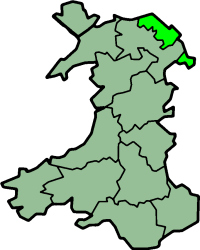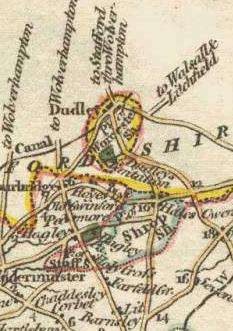List of county exclaves in England and Wales 1844–1974
Until 1844, many of the counties in England and Wales had exclaves or detached parts, entirely surrounded by other counties. The Counties (Detached Parts) Act 1844 resulted in many of these exclaves being absorbed by the county in which they were locally situated. Nevertheless, a number of exclaves remained; which were dealt with in a piecemeal manner over a period of decades.
The Local Government Act 1894 empowered the county councils of administrative counties to exchange areas in order to make a more effective local government area. As the Local Government Act 1888 had redefined the lieutenancy and shrievalty to be based on administrative counties, the changes also affected them as well as judicial boundaries. Accordingly, many anomalies in county boundaries were removed in the next three years, including the elimination of outlying areas of Derbyshire and Huntingdonshire.
The last major transfer of areas was in 1931, when the boundaries of Gloucestershire, Warwickshire and Worcestershire were realigned. Following the creation of a new administrative county of Huntingdon and Peterborough in 1965, and boundary changes at Dudley in 1966, Flintshire was left as the only county with detached areas — these remained right up to the abolition of the county council in 1974.
Areas transferred
Caernarvonshire
The detached parish of Llysfaen was transferred to Denbighshire and the urban district of Colwyn Bay in 1923.
Derbyshire
- In 1884, the three separate detached parts of the parish of Packington, including the chapelry of Snibston, were transferred to Leicestershire, where they formed part of the new parish of Ravenstone with Snibston.
- A block of parishes: Appleby Magna North, Chilcote, Measham, Oakthorpe and Donisthorpe (partly in Leicestershire), Stretton en le Field and Willesley transferred to Leicestershire 1897. At the same time, the parishes of Netherseal and Overseal were received from Leicestershire.
Flintshire

Flintshire was unique in maintaining exclaves until 1974.
- The largest of these was the area of Maelor Saesneg, which became the Overton Rural District in 1894, and was renamed Maelor Rural District in 1953.
- The other area was the township of Marford and Hosely, in the parish of Gresford (otherwise in Denbighshire). Originally, this included five separate exclaves, but exchanges with Denbighshire in 1885 reduced the area to a single outlier. Marford and Hosely became a parish in the Hawarden Rural District in 1894, although surrounded by Wrexham Rural District in Denbighshire. It remained an exclave until local government reorganisation in 1974, when the two rural districts were united in Wrexham Maelor.
Gloucestershire
After 1844, Gloucestershire had no detached parts, although the areas that became Campden Rural District and Pebworth Rural District were only joined to the rest of the county by narrow necks of land. In 1931, the county's boundaries with Warwickshire and Worcestershire were realigned, removing the narrow salients from Gloucestershire; in compensation, Gloucestershire gained a number of detached Worcestershire parishes.
Herefordshire
The detached parish of Fwthog was transferred to Monmouthshire in 1891.
Huntingdonshire
- The parish of Swineshead was a detached part of the county surrounded by Bedfordshire. In 1896, the parish was transferred to Bedfordshire in exchange for the parish of Tilbrook.
- Part of the parish of Tetworth was an exclave of Huntingdonshire, separated from the rest of the county by a salient of Cambridgeshire. This situation remained until 1965, when the county of Huntingdon and Peterborough was formed, and parish and county boundaries were adjusted to remove the detached part.
Lancashire

Lees Urban District was an exclave of the administrative county of Lancashire, being separated from the rest of the county by the County Borough of Oldham (shown within the hundred of Salford in the map to the right), and enclosed on the other side by Saddleworth Urban District in the West Riding of Yorkshire. The Urban District was abolished by the Local Government Act 1972, taking effect on 1 April 1974, with its former area transferred to the newly-created metropolitan county of Greater Manchester, with much of the hundred of Salford to form part of the new Metropolitan Borough of Oldham, where it was also joined by Saddleworth.
Additionally, the North Lonsdale area of Lancashire, or "Lancashire north of the sands", was cut off from the main body of Lancashire by Westmorland and Morecambe Bay. This area was transferred to Cumbria by the Local Government Act 1972.
County of London
When the county was formed in 1889, it was made up of a number of parishes in Kent, Surrey and Middlesex. One parish in the latter, Clerkenwell, had a detached part that became an exclave of London surrounded by Middlesex. The area — Alexandra Park — was absorbed by Middlesex in 1899.
Middlesex
Until 1889, Middlesex did not have any detached parts, but the formation of the County of London left two small exclaves of the parish and urban district of South Hornsey surrounded by the new county. This situation lasted until 1899, when the whole of South Hornsey passed to the County of London. At the same time, Alexandra Park, an outlier of the parish of Clerkenwell in London, was transferred to Middlesex.
Staffordshire
In 1889, the extra-parochial place of Dudley Castle, formerly in Worcestershire, became a detached part of Staffordshire, surrounded by the county borough of Dudley, itself a detached part of Worcestershire. In 1894, the area became the only parish in Dudley Rural District. In 1929, it was absorbed by the civil parish and county borough of Dudley, Worcestershire.
Warwickshire
Ilmington, Stretton-on-Fosse and Whitchurch formed a detached part of Warwickshire, separated from the main part of the county by an exclave of four Worcestershire parishes. In 1931, the intervening area of Worcestershire was transferred to Warwickshire, so that the three parishes became joined to the rest of the county.
Worcestershire

- The parish of Edvin Loach was transferred to Herefordshire in 1893
- Cutsdean, originally a chapelry in the parish of Bredon, became a civil parish in 1866. It was transferred to Gloucestershire 1931.
- Blockley parish transferred to Gloucestershire in 1931.
- Daylesford parish transferred to Gloucestershire in 1931.
- Evenlode parish transferred to Gloucestershire in 1931.
- Alderminster, Shipston-on-Stour, Tidmington and Tredington parishes joined with Blockley in 1894 to form Shipston-on-Stour Rural District. The district transferred to Warwickshire 1931.
- In 1889, Dudley became a county borough, but remained a detached part of Worcestershire for non-administrative reasons. In 1966, the county borough absorbed surrounding areas of the administrative county of Staffordshire, and from that date was included in Staffordshire.